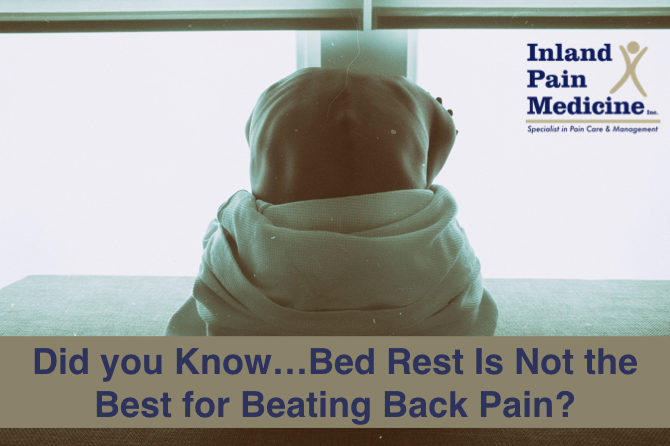
Severe low back pain is a common and dreaded problem that plagues many people around the world. The natural response to severe pain is to rest the injured body part and reduce normal activities while it heals. However, studies comparing bed rest to more active treatment for acute back pain have reached the same conclusion: bed rest is not best for beating pack pain.
Light activity, such as short walks around the house or sitting upright for brief periods throughout the day, reduces the requirement for medication, shortens absences from work and results in fewer visits to health-care professionals.
Bed rest isn’t totally useless, but we know it should be reduced to the shortest time possible.
Let’s look at why staying active helps the lower back.
The Brain’s Job
Those who overlook medical advice and avoid activity may be doing so because they’re trying to cope with high pain levels by avoiding all possible movements which may increase it. But the resulting bed rest has a compounding effect on the level and duration of their pain.
Long periods of immobility give the lumbar-stabilizing muscles time to lose strength, making recovery of normal movements more difficult when the initial pain settles.
A fearful emotional response to back pain often results in longer recovery and higher risk of long term disability. The immediate response to rest the back may reflect a hardwired predisposition in the brain.
So remember: You are not to blame for how your brain reacts in a major pain crisis!
The Unhealthy Cycle
A vicious cycle of pain followed by more rest, followed by new pain due to that rest, can spiral downwards over a couple of months and leave you with abnormal movement patterns.
Reestablishing trust in your back is vital. This trust tends to be eroded by prolonged bed rest. Anyone put to bed for more than a couple of days will develop stiffness and pain in the muscles and joints, and this is equally true for the back.
The Good News
It’s encouraging to know that more than 80% of lower back pain will resolve within six weeks regardless of the treatment approach used.
The goal of managing acute back pain is to reduce it to a point where the sufferer can stay moderately active while the pain settles over the usual four-to-six-week period.
With sensible activity and treatment plans, acute back pain sufferers have good outcomes 95% of the time.
Allow us to share our medical expertise with you. For more information on interventional procedures, call us today at (909) 887-2991.
Leave a reply








A very nice blog that you have shared.
visit Meddco Healthcare: https://www.meddco.com/ for affordable healthcare packages
Thank you for keep sharing.
ReplyI never knew that avoiding activity could possibly lead to more pain due to a compounding effect. My husband hurt his back recently and has been wondering whether or not he should rest or look for more advice. I think that he should look for a professional with experience in back pain treatment to help him figure out what is wrong with him as well as the best course of action.
ReplyIt’s interesting to know that long periods without moving will make your lumbar muscle to lose strength. My husband has been struggling with back problems, and we are looking for advice to help him. I will let him read your article to help him understand what will be the best way to prevent back problems.
ReplyGood, precise, and informative content. Thank you so much for sharing a great post. Got to know a lot of things about this TOPIC.
ReplyVery informative post. I’ve been struggling with back pain for a while not, I’m seated all day and my chair is uncomfy. I thought I had to live with this pain. But, According to the article, moving around will help my back heal. Thank you for the info.
Reply